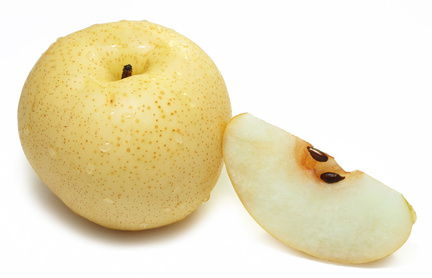
Health Benefits:
Aids in digestion
Aids in weight loss
Anti inflammatory
Detoxifying effects
Helps control LDL cholesterol levels
May reduce cholesterol
May reduce risk of cancer
May reduce risk of diabetes
May reduce risk of heart disease
Promotes heart health
Reduces risk of colon cancer
Relieves constipation
Nutrition:
Serving size: 1 fruit; Calories: 51; Fat: 0.3g; Cholesterol: 0mg; Sodium: 0mg; Carbs: 13g; Fiber: 4.4g; Sugars: 9g; Protein: 0.6g; Potassium: 4%DV; Vitamin A: 0%DV; Vitamin C: 8%DV; Calcium: 0%DV; Iron: 0%DV
Did You Know?
- In Chinese medicine Asian pears are considered a cooling fruit and are used for detoxification purposes and to treat coughs, laryngitis, ulcers and constipation
- Asian pears make a great substitute for apples
- Different varieties of asian pears include:
- Hosui: Large, yellowish-brown, russet fruit with prominent lenticels and excellent quality. Many prefer the taste of this variety. Fruit must be thinned to obtain adequate size. Fruit matures mid- to late August.
- Kosui: Apple-shaped, small- to medium-sized fruit. Skin is brown and fruit mature in mid- to late August.
- Olympic: Fruits are large, late, round, and have an attractive golden russetted skin. Reportedly, this pear's bloom period overlaps with Bartlett, and the two make compatible pollinizers. Olympic has the longest storage life of the Asian pears
- Shinseiki (New Century): Yellow-green to yellowskinned type, medium-sized, good- to excellent-flavored fruit that ripens early. Flesh is creamy white with a very sweet taste. Fruit is round to oblong.
- Twentieth Century (Nijisseiki): Yellow-skinned type that is the most popular variety worldwide. It has very good medium to large fruit. One of the most susceptible to fire blight
Ways to Eat:
- Raw
- Baked
- In salads and baked goods
Farming Trivia:
- The Asian pear tree is native to Asia and has other names such as the nashi pear, sand pear and apple pear
- Today Asian pears are grown not only throughout Asia but in Italy, Spain, Australia, France, Chile and New Zealand as well
- Though they are not related to apples, Asian pears are often referred to as apple pears because of their crisp and juicy apple like consistency
- Asian pears, unlike European pears, ripen on the tree.
- They are are ready for harvest when you easily remove them from the spur or branch by slightly lifting and twisting them.
- Asian pear is a fruit from the tree with the scientific name Pyrus pyrifolia.
Note: Always consult a physician for any specific health questions and concerns. Some of this information may be subject to change should there be any new findings from Federal Health Administration (FHA), Food & Drug Administration (FDA), American Medical Association (AMA), American Cancer Society (ACS), and / or other leading food, nutrition and medical advisors.

